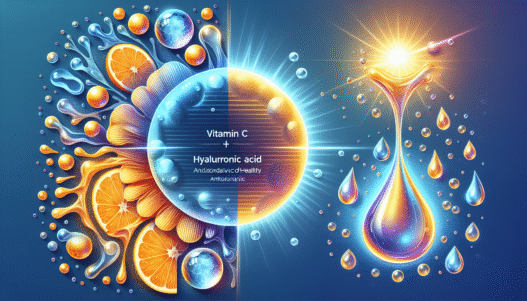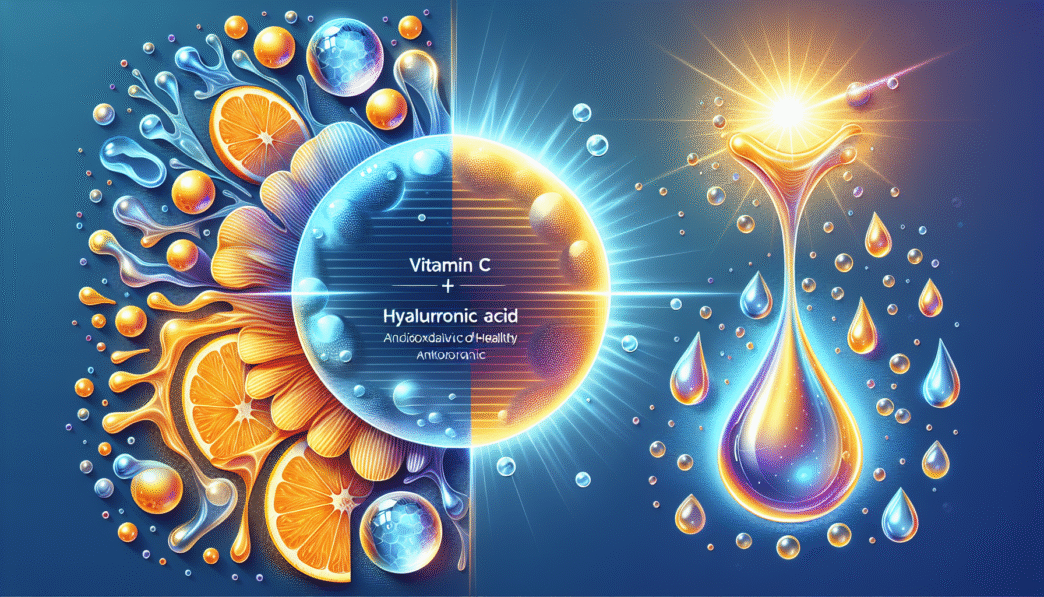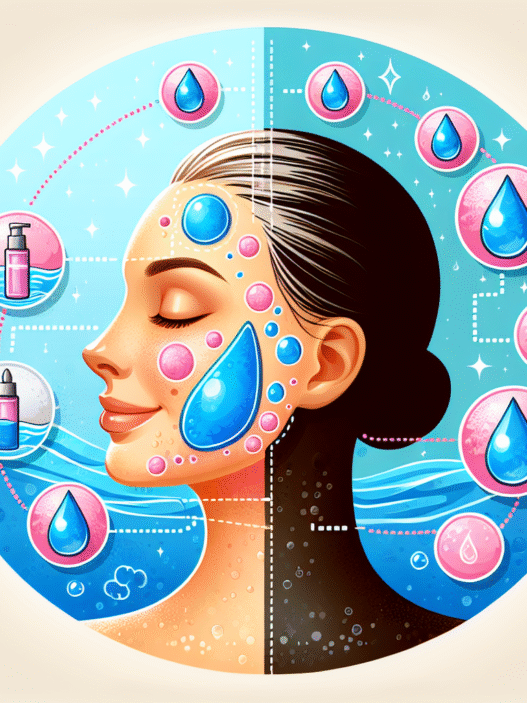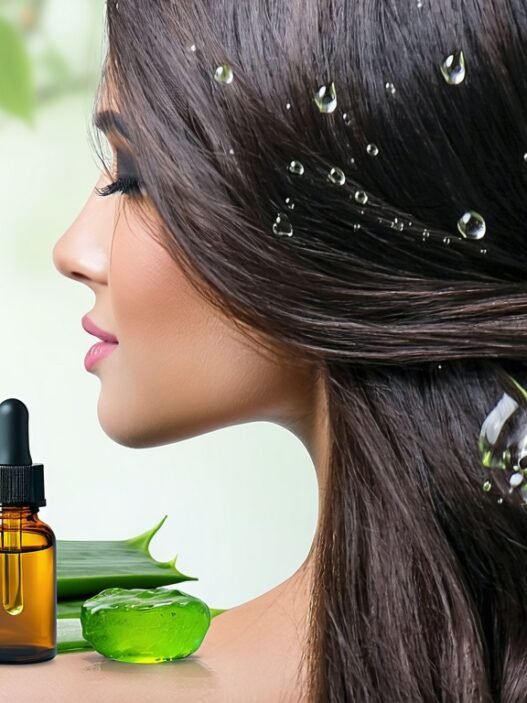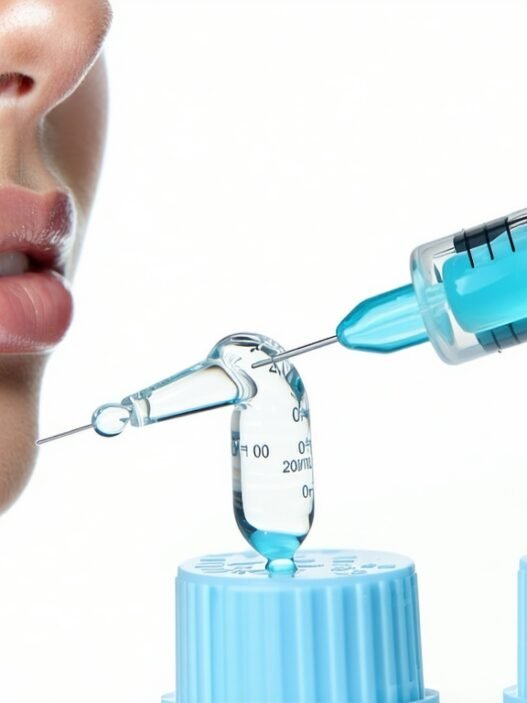Vitamin C Role in Skin Health
Vitamin C is a well-known nutrient that plays a crucial role in maintaining skin health. Its importance cannot be overstated, especially concerning collagen production and wound healing, both essential for youthful and resilient skin.
Collagen Production Boost
Collagen is a necessary protein that helps maintain skin structure and elasticity. Vitamin C plays a critical role in maintaining a normal mature collagen network in humans. It prevents the auto-inactivation of key enzymes involved in collagen biosynthesis, which ultimately contributes to optimal collagenic density in the dermis.
The process of collagen synthesis requires Vitamin C as a cofactor for enzymes such as prolyl hydroxylase and lysyl hydroxylase. These enzymes catalyze the hydroxylation of procollagen’s proline and lysine residues, promoting the proper folding of the collagen triple-helix conformation. This mechanism is vital for ensuring structural integrity and strength in the skin.
A comparison of collagen synthesis with and without Vitamin C highlights its impact:
| Condition | Vitamin C Present | Vitamin C Absent |
|---|---|---|
| Collagen Production | Enhanced | Reduced |
| Structure Integrity | Optimal | Compromised |
Wound Healing Support
Vitamin C is also essential in supporting the healing of skin wounds. It aids in collagen production, which is crucial for wound closure. Studies have shown that vitamin C can help wounds heal faster, making it beneficial for various forms of skin injuries and scarring.
The antioxidant properties of Vitamin C further assist in the healing process by neutralizing reactive oxygen species that can lead to cell apoptosis (PubMed Central). This antioxidant action helps to mitigate oxidative stress, which can impair healing.
Additionally, preclinical studies demonstrated enhancements in bone healing after fractures with vitamin C supplementation, emphasizing its broader implications on tissue repair (PubMed Central). It can be consumed through the diet, taken as supplements, or applied topically to provide these benefits.
Overall, Vitamin C is vital for not only maintaining skin structure but also for promoting effective healing processes, making it a key player in anti-aging skincare routines. For further insights into the role of hyaluronic acid, check out what does hyaluronic acid do to your skin?.
Benefits of Topical Vitamin C
Topical Vitamin C offers numerous benefits for skin health, particularly in the realms of wrinkle reduction and protection against sun damage.
Wrinkle Reduction
One of the most significant advantages of applying Vitamin C to the skin is its ability to reduce the appearance of wrinkles. Clinical studies have shown that consistent use of Vitamin C can improve both fine and coarse wrinkles, as well as the overall texture and appearance of the skin. Regular application over a period of at least three months can yield noticeable improvements.
| Duration of Use | Noticeable Improvement |
|---|---|
| 12 weeks | Reduction in appearance of wrinkles |
| 16 weeks | Significant reduction in hyperpigmentation patches |
Vitamin C acts as an antioxidant, fighting off harmful free radicals that contribute to skin aging. These free radicals can result from external factors like pollution and internal processes such as metabolism. By mitigating their effects, Vitamin C not only preserves the skin’s youthful appearance but also aids in the overall health of the skin.
Sun Damage Protection
Another key benefit of Vitamin C is its protective role against sun damage. Regular use of Vitamin C is known to enhance the skin’s defenses, helping to prevent early signs of skin aging caused by harmful UV rays (Harvard Health Publishing). This antioxidant assists in preventing the formation of dark spots, which are often a result of sun exposure.
Moreover, in a study wherein Vitamin C was applied to the skin for 16 weeks, participants noted a significant reduction in hyperpigmentation patches, indicating its effectiveness against sun-induced damage. Topical Vitamin C can, therefore, be an integral part of a robust skincare routine aimed at promoting healthy skin while combating the effects of aging.
In summary, understanding what do vitamin c and hyaluronic acid do? can enhance skincare results, particularly when considering their roles in wrinkle reduction and protection from sun damage. To further explore the benefits hyaluronic acid offers, consider checking out our article on what does hyaluronic acid do to your skin?.
Hyaluronic Acid Functionality
Moisture Retention Mechanism
Hyaluronic acid (HA) is renowned for its remarkable ability to retain moisture. It can bind up to 1000 times its weight in water, effectively acting as a humectant. This means it helps keep the skin hydrated by preventing water evaporation from the surface. As individuals age, the natural levels of hyaluronic acid in the skin decrease, leading to a reduction in moisture content and an increase in the appearance of fine lines and wrinkles. Replenishing HA through topical products can mitigate these signs of aging and promote a more youthful appearance.
The moisture retention properties can lead to a visible increase in skin plumpness and hydration. The table below outlines the moisture-binding capacity of hyaluronic acid:
| Property | Value |
|---|---|
| Water Binding Capacity | 1000 times its weight |
| Most Beneficial Molecular Weight | 50 to 1,000 kDa |
| Optimal Size for Elasticity | 130 kDa increases elasticity by 20% |
Hyaluronic acid also plays a role in improving wound healing, making it essential for overall skin health.
Skin Elasticity Improvement
In addition to moisture retention, hyaluronic acid contributes significantly to skin elasticity. The optimal molecular weight of HA (around 130 kDa) has been shown to enhance skin elasticity by 20%. As skin loses its firmness with age, maintaining adequate levels of hyaluronic acid can combat sagging and improve overall texture (Healthline).
Skin elasticity refers to the skin’s ability to stretch and bounce back, which is crucial for maintaining a youthful appearance. As the production of collagen, elastin, and hyaluronic acid declines with age, the skin becomes less resilient. Incorporating products with hyaluronic acid can aid in restoring some of this lost elasticity, resulting in firmer, more resilient skin.
For a deeper understanding of how hyaluronic acid interacts with other skincare ingredients and functions in anti-aging, it is helpful to explore the topic further through resources such as what do vitamin c and hyaluronic acid do?.
Hyaluronic Acid Types
Understanding the different types of hyaluronic acid (HA) is essential for those interested in its anti-aging benefits. HA’s effectiveness varies based on its molecular weight, which influences its penetrative properties and overall impact on skin health.
Molecular Weight Variations
Hyaluronic acid comes in various molecular weights, each impacting skin in different ways. Studies indicate that HA molecules between 50 to 1,000 kDa (kilodaltons) are most beneficial for skin health, with 130 kDa recognized as the optimal size for enhancing skin elasticity by 20%. Molecules that are lower in weight may lead to inflammation, while those that are higher offer minimal improvements to the skin.
Here is a table summarizing the effects of different molecular weights of hyaluronic acid:
| Molecular Weight (kDa) | Benefit | Consideration |
|---|---|---|
| Below 50 | Minimal penetration | May cause inflammation |
| 50 – 500 | Surface hydration | Varies in penetration efficiency |
| 130 | Enhanced elasticity | Optimal size for skin improvement |
| Above 500 | Surface hydration only | Limited impact on skin improvement |
Penetrative Properties
The penetrative capabilities of hyaluronic acid molecules dramatically differ based on their size. Recent research reveals that smaller HA molecules, specifically those under 500 kDa, are more effective at penetrating the skin compared to larger HA molecules, which often remain on the surface (Healthline).
For superficial hydration, topical HA products predominantly feature larger molecules that hydrate the skin’s outer layers. Conversely, for deeper hydration, it’s crucial to choose products containing a range of HA molecular sizes. Smaller HA molecules can effectively reach the deeper layers of the epidermis, providing more substantial hydration and contributing to skin rejuvenation.
A comprehensive formulation combining different molecular weights can ensure both surface and deeper hydration, addressing diverse skin needs. This versatility in formulations highlights the importance of understanding HA types to meet specific skincare goals. For insights on whether hyaluronic acid can help with issues like wrinkles, visit does hyaluronic acid help wrinkles?.
Combining Vitamin C and Hyaluronic Acid
Synergistic Benefits
The combination of vitamin C and hyaluronic acid creates a powerful duo for skin health. Topical vitamin C acts as a potent antioxidant that combats harmful free radicals, preventing damage from external factors like air pollution. This protective quality complements hyaluronic acid’s ability to retain moisture, contributing to overall skin wellness.
Furthermore, vitamin C is known to promote collagen production, which is essential for maintaining skin elasticity and preventing sagging. In conjunction with this, hyaluronic acid binds water molecules, which enhances skin hydration, flexibility, and elasticity. Together, they significantly improve the skin’s appearance (WebMD).
| Benefit | Vitamin C | Hyaluronic Acid |
|---|---|---|
| Antioxidant Protection | Yes | No |
| Collagen Production | Yes | No |
| Moisture Retention | No | Yes |
| Skin Elasticity | Yes | Yes |
Recommended Usage Practices
For optimal results, it is recommended to use topical hyaluronic acid (HA) products that offer hydration at various levels of the skin. Selecting products containing a variety of HA molecule sizes can help with deeper hydration penetration, which enhances the efficacy of topical vitamin C applications (Harvard Health Publishing).
Additionally, injecting HA fillers can effectively address various cosmetic concerns, such as improving skin texture and adding volume. This process complements the action of topical vitamin C, particularly in reducing wrinkles and providing protection against sun damage.
For those interested in exploring how vitamin C and hyaluronic acid interact with other skincare products, including which ones to avoid, check out our content on what not to mix with hyaluronic acid?.










